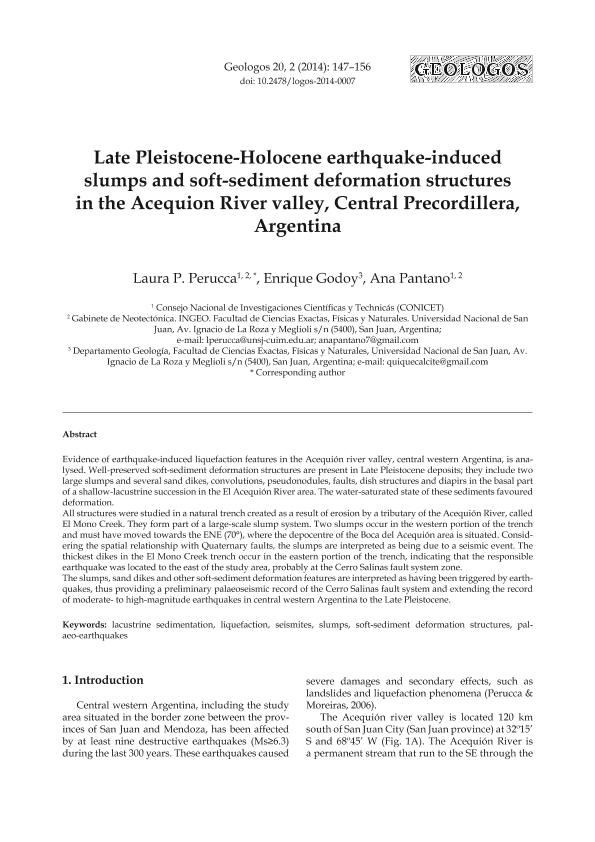Artículo
Late Pleistocene-Holocene earthquake-inducedslumps and soft-sediment deformation structures in the Acequion River valley, Central Precordillera, Argentina
Fecha de publicación:
07/2014
Editorial:
De Gruyter
Revista:
Geologos
ISSN:
2080-6574
Idioma:
Inglés
Tipo de recurso:
Artículo publicado
Clasificación temática:
Resumen
Evidence of earthquake-induced liquefaction features in the Acequión river valley, central western Argentina, is analysed. Well-preserved soft-sediment deformation structures are present in Late Pleistocene deposits; they include two large slumps and several sand dikes, convolutions, pseudonodules, faults, dish structures and diapirs in the basal part of a shallow-lacustrine succession in the El Acequión River area. The water-saturated state of these sediments favoured deformation.
All structures were studied in a natural trench created as a result of erosion by a tributary of the Acequión River, called El Mono Creek. They form part of a large-scale slump system. Two slumps occur in the western portion of the trench and must have moved towards the ENE (70°), where the depocentre of the Boca del Acequión area is situated. Considering the spatial relationship with Quaternary faults, the slumps are interpreted as being due to a seismic event. The thickest dikes in the El Mono Creek trench occur in the eastern portion of the trench, indicating that the responsible earthquake was located to the east of the study area, probably at the Cerro Salinas fault system zone.
The slumps, sand dikes and other soft-sediment deformation features are interpreted as having been triggered by earthquakes, thus providing a preliminary palaeoseismic record of the Cerro Salinas fault system and extending the record of moderate-to high-magnitude earthquakes in central western Argentina to the Late Pleistocene.
Palabras clave:
Lacustrine
,
Liquefaction
,
Slumps
,
Earthquake
Archivos asociados
Licencia
Identificadores
Colecciones
Articulos(CIGEOBIO)
Articulos de CENTRO DE INVESTIGACIONES DE LA GEOSFERA Y BIOSFERA
Articulos de CENTRO DE INVESTIGACIONES DE LA GEOSFERA Y BIOSFERA
Articulos(SEDE CENTRAL)
Articulos de SEDE CENTRAL
Articulos de SEDE CENTRAL
Citación
Perucca, Laura Patricia A.; Godoy, Enrique; Pantano Zuñiga, Ana Vanesa; Late Pleistocene-Holocene earthquake-inducedslumps and soft-sediment deformation structures in the Acequion River valley, Central Precordillera, Argentina; De Gruyter; Geologos; 20; 2; 7-2014; 147-156
Compartir
Altmétricas




